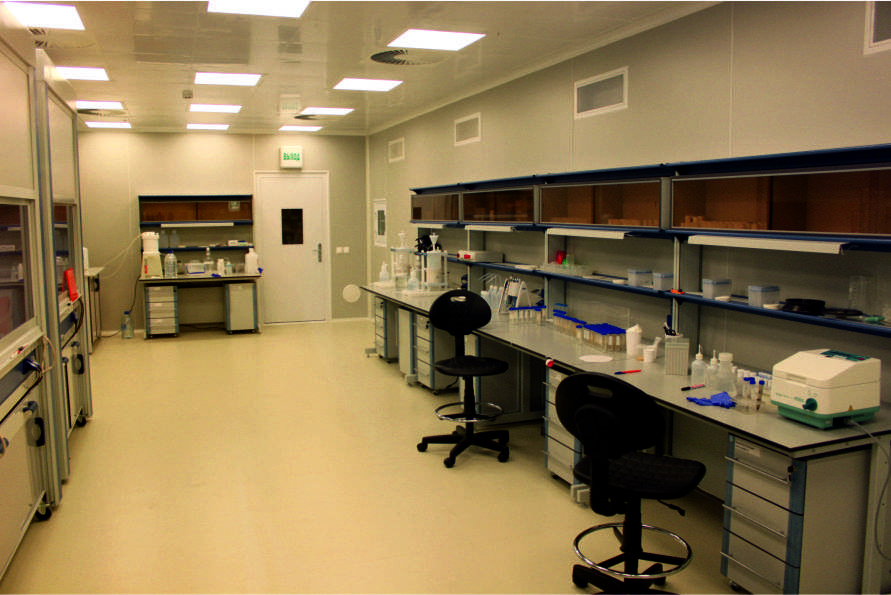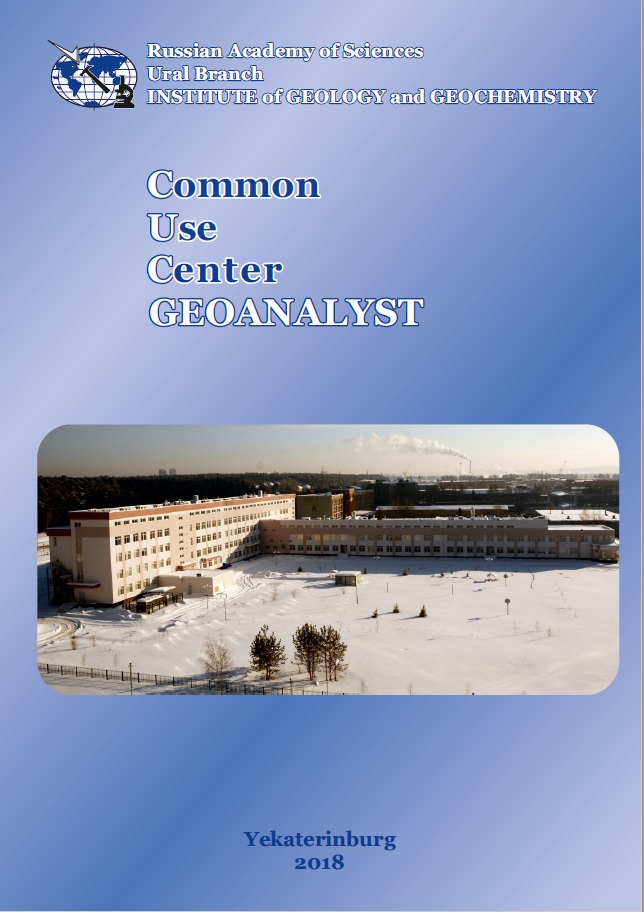Common Use Center of the Ural Branch of RAS “Geoanalyst”
The Common Use Center “Geoanalyst” was established in 2006 on the basis of the institute analitycal laboratory. “Geoanalyst” is an interdisciplinary center research center outfitted with up-to-date analytical equipment and a variety of techniques. The equipment can provide quantitative information about the chemical (elemental and isotope) and phase composition, the crystal and electronic structure parameters, the lattice defect type, and the optical properties of minerals, rocks, soils, sediments, ores, products of their enrichment, as well as synthetic compounds, technogenic and biogenic objects. The equipment is located in specialized facilities with systems of inflowing and outflowing ventilation, climate control, etc. Their total area is about 1000 sq.m. The equipment for chemical decomposition, chromatographic separation and subsequent study of trace-element and isotope composition of samples is located in the cleanrooms of purity class 10 000 and 1 000 (ISO 7 and 6); their total area is about 600 sq.m. Areas of Activity
Twenty-three employees including 10 under the age of 35, one academician of RAS, 5 candidates of science, 3 postgraduate students, 6 groups working in the following areas:
Head of the Common Use Center “Geoanalyst” - Sergey L. Votyakov, Academician of the RAS. Tel. 8-343-2879013. E-mail: votyakov@igg.uran.ru Deputy Head of the Common User Center “Geoanalyst” - Dmitry A. Zamyatin, Ph.D. Tel. 8-343-2879030. E-mail: zamyatin@igg.uran.ru Website: www.geoanalyst.igg.uran.ru 620016, Yekaterinburg, Academician Vonsovsky Street, 15. The Common User Center “Geoanalyst” is willing to collaborate with geological, environmental and any other interested organizations in providing analyses of samples, and organizing training courses, workshops, seminars and exhibitions. |
Analytical equipment
Electron microprobe analysis and microscopy

Microanalyzer Cameca SX100 with five wavelength spectrometers and Bruker Xflash6 energy dispersive spectrometer; devices for carbon and metal coating Q150TES (Quorum Technologies). The equipment provides quantitative analysis of elements from light ones Be, O, F to U in samples with a content of 0.01 to 100 wt.% and with lateral (depth) resolution down to 1 μm; elemental mapping, SE, BSE and CL imaging of grains; analysis of its internal texture, revealing of domains and mineral inclusions using the JPD (Joint Probability Distribution) method [Votyakov, et al., 2014, Zamyatin et al., 2017]; chemical U-Th-total Pb dating of U-Th minerals [Votyakov et al., 2011].

Scanning electron microscope JSM-6390LV (Jeol) with an energy dispersing attachment INCA Energy 450 X-Max 80 and EBSD attachment (NordlysNano Oxford Instruments). The equipment provides microobject imaging (maximum magnification up to 300 000; high- and low-vacuum operating modes; the latter one for biological object analysis); pseudo-3D image analysis of using software package Mex 5.1; semiquantitative (qualitative) analysis of elements from Na to U with a content of 0.1 to 100 wt%; obtaining diffraction patterns of backscattered electrons.
X-ray fluorescence analysis

X-ray fluorescence energy dispersive spectrometer EDX-8000 (Shimadzu, Japan).

XRF 1800 X-ray fluorescence spectrometer (Shimadzu, Japan ).

X-ray fluorescence multichannel spectrometer SRM-35 (Nauchpribor, Russia).

X-ray fluorescence spectrometer VRA-30 (Carl Zeiss, Germany). The equipment provides non-destructive, quantitative, semiquantitative and operative qualitative analysis of solid-phase materials with the evaluation of rock-forming and impurity elements from Na to U with a content of 0.1 to 100 wt.% and locality up to 1 mm.
X-ray diffraction and thermal analysis

XRD-7000 Diffractometer (Shimadzu, Japan) with polycapillary optics and high temperature attachment NTK-1200N (Anton Paar) to operate in the temperature range 25-1.500°C. The equipment provides investigation of the structure of crystalline materials; analysis of the sample perfection degree; evaluation of the phase composition of polycomponent samples (quantitative, non-standard full-profile analysis of diffractograms of powder samples using the software complex SiroQuant with a built-in database and recalculation of the mineral content in oxides with the X-ray fluorescence control); analysis of clay minerals based on the study of oriented samples [Ryanskaya, Gulyaeva, 2017], etc.

Diamond TG-DTA Thermal Analyzer (Perkin Elmer). The equipment provides investigation of the thermal characteristics of rocks and minerals (weighting more than 3-10 mg) in the range of 25-1.500°C; the study of oxidation process, degassing of OH-groups and water separation, etc.
Microelement mass-spectrometry, atomic emission and atomic absorption analysis

The sample preparation for microelement analysis is carried out in the Class 1 000 (ISO 6) cleanroom equipped with high-pressure and microwave digestion systems for the decomposition of rocks, minerals, ores, technogenic products, metals and alloys: Ural-Gefest PLP-01 and Berghof Speedwave MWS-3 + and MWS-4+ systems of microwave digestion, Ankon AT MKP-05 and Berghof high-pressure digestion (autoclave) systems, etc. Ultra-pure reagents (acids purified by sub-boiling distillation, 18.2 MOm·cm deionized water) and PTFE and polypropylene labware are used.

ELAN 9000 quadrupole mass-spectrometer with inductively coupled plasma and LSX-500 attachment for sample laser ablation. The equipment provides simultaneous analysis of trace elements (Li, B, Be, Sc, Ti, Cr, Ni, V, Co, Cu, Zn, Ga, Rb, Sr, Y, Zr, Nb, Mo, Sb, Cs, Ba, Hf, Ta, Pb, Th , U, etc) up to 0.n ppm in liquids and solid samples.

UP266 Macro attachment for sample laser ablation with ELAN 9000 quadrupole mass-spectrometer.

NexION 300S inductively coupled plasma mass-spectrometer with New Wave Research NWR213 laser ablation system. Zircon U-Pb dating is carried out by LA-ICP-MS with a crater diameter of at least 25 μm.

Perkin Elmer Optima 8000 inductively coupled plasma atomic emission spectrometer.

Analityk Jena ContrAA 700 high-resolution continuum source atomic absorption spectrometer both with flame and electrothermal atomization in graphite furnace. Optima 8000 and ContrAA 700 provide high-precision high-throughput analysis of trace (Li, Be, Sc, Ti, Cr, Ni, V, Co, Cu, Zn, Ga, Rb, Sr, Y, Zr, Nb, Mo, Sb, Cs, Ba, Hf, Ta, Pb, Th , U) and rare earth elements at ppm levels in rock and mineral solutions.
Isotope mass-spectrometry and geochronology

The sample preparation for isotopic analysis is carried out in the Class 1 000 (ISO 6) cleanroom equipped with Ekros and TomAnalit heating plates, a programmable SNOL heating and drying oven for sample decomposition, an antistatic kit for Mettler Toledo analytical balance, etc. Ultra-pure reagents (water and acids purified by double sub-boiling distillation) and Nalgene and Savillex PTFE and PFA labware are used.

Thermo Fisher Scientific Triton Plus thermal ionization multicollector mass-spectrometer.

Thermo Fisher Scientific Neptune Plus inductively coupled plasma multicollector mass-spectrometer. Triton Plus and Neptune Plus provide the analysis of Sm-Nd and Rb-Sr isotope composition of rocks and minerals using the isotopic dilution (ID) method by Triton Plus; the analysis of the Sm-Nd (ID), Sr (SSB, standard-sample-bracketing) and Pb (Tl-normalization method) isotope composition of rocks and minerals by Neptune Plus.
Physics and spectroscopy of minerals

Horiba LabRam HR800 Evolution spectrometer (1800 and 600 pcs/mm gratings) with the Olympus BX-FM microscope, Linkam THMS 600 thermostat and He-Ne and Ar lasers (633, 514 and 488 nm lines). The equipment provides the study of Raman spectra of minerals and other materials and fluid inclusions with spatial resolution up to 1 μm and spectral resolution of 0.8-1 cm in the temperature range of 78-873 K; identification of phases; grain mapping based on the Raman spectra parameters the study of local features of mineral structure and composition (deformations and strains, solid solutions, structural imperfection, radiation damage, etc.); the investigation of the thermal structural transformations and phase transitions, etc.

CLAVI pulsed cathodoluminescence analyzer with temporal resolution and Horiba LabRam HR800 spectrometer. The equipment provides the study of the luminescence spectra of the minerals at 78-873 K under excitation by Ar and He-Ne lasers; the grain mapping with respect to spectral parameters; the analysis of pulsed cathodoluminescence of the minerals.

Spectrum One infrared Fourier spectrometer with Multiscope microscope (PerkinElmer). The equipment provides the study of IR spectra of minerals; qualitative identification of phases; the study of local features of mineral structure and composition; estimation of OH-groups concentration in the grains of nominally anhydrous silicates (olivine, pyroxenes) with a spatial resolution of 50 μm and above.

ESR-70-03 DX/2 electron spin resonance spectrometer with the attachment to operate in the temperature range 77-400 K. The equipment provides the study of electron spin resonance spectra of minerals in the initial state and after various types of irradiation and annealing; investigation their micro- and nanostructure, type, local structure and concentration of paramagnetic defects; estimation of the distribution of paramagnetic ions in solid solutions of minerals; analysis of radiation phenomena; paleodosimetric reconstructions, etc.
Computer simulation of the mineral structure and properties
Software products - ab initio cluster Xα-DVM discrete variation method [Averill, Ellis, 1977], GULP semi-empirical method of atomistic structure simulation [Gale, 2010], DL-POLY method of molecular dynamics [Todorov, Smith, 2010] and Monte -Carlo SRIM [Zeigler, 2008]. Software products simulation of atomic and electronic structure of minerals, chemical bonding, structure and spectroscopic properties of the defects, calculation of thermodynamic properties and structure of solid solutions, simulation of radiation and matter interaction.


